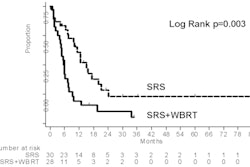In 2008, 41,800 women were diagnosed with endometrial cancer, and approximately one-third of them had radiation therapy to treat the disease. But radiation therapy for women with early-stage, low-risk endometrial cancer has been controversial due to the possible risk of developing additional cancers -- a concern recently verified by Michigan researchers.
A research team from Wayne State University in Detroit analyzed the prevalence of second cancers in a cohort of 90,502 women with a recorded diagnosis of endometrial cancer as their first malignancy between 1973 and 2004. The researchers published their findings in the May 2009 issue of Gynecologic Oncology (Vol. 113:2, pp. 233-239).
Data were obtained from nine registries, representing different geographic regions of the U.S., of the Surveillance, Epidemiology, and End Results (SEER) database. The data represented 814,892 person-years, in which subjects were followed annually until the date of second cancer diagnosis, date of last follow-up, date of death, or end of calendar year 2004, whichever came first.
Approximately 35%, or 31,643, of the patients in the study had received radiation therapy, which included beam radiation, radioactive implants, radioisotopes, or combinations of these treatments. Some 57.6%, or 52,182, did not receive radiation therapy. Radiation treatment was unknown for 7.3%.
Twice as many patients with grade I endometrial cancer did not receive radiation therapy as those who did (53.1% versus 25.9%), while the opposite was true of patients diagnosed with grade III cancer (15.3% versus 34.7%). Patients with grade II cancer were almost equally divided, with 31.5% not receiving radiation therapy and 39.3% receiving it.
During the 31-year time span, 13.3% of the group who received radiation therapy developed a second cancer, compared with 10.7% who did not receive radiation. Patients who received radiation therapy at a mean age of 64.5 years developed a second cancer at a mean of 9.7 years later. Patients who were diagnosed at a mean age of 62.6 years and did not receive radiation therapy developed a second cancer a mean of 9.4 years later.
Life-table methods were used by the researchers to calculate cumulative probabilities of developing second cancers over time. The standardized incidence ratio of all second malignancies combined was significantly higher at 0.95 for the patients who received radiation as compared to 0.820 for the patients who received no radiation, according to lead author Dr. Sanjeev Kumar, a resident in obstetrics and gynecology at Wayne State University School of Medicine and the Karmanos Cancer Institute in Detroit.
The percent increase in the relative risk of developing a second cancer increased in a time-dependent fashion after exposure to radiation therapy. For these patients, the relative risk increased to 25% 13 to 18 years after treatment, 47% at 24 to 29 years, and 123% after 30 years.
The majority of the risk facing patients who receive radiation therapy is due to the development of solid tumors in the field of exposure. This increases as a function of time, the researchers reported.
Of the total of 9,766 second cancers, 31.7% were breast cancers. Prior studies have identified an increased risk of breast cancer for endometrial cancer patients, and on a percentage basis, the rates were comparable (3.69% for women who received radiation therapy, compared with 3.68% who did not).
Second cancers of patients who received radiation therapy
|
Second cancers of patients who had no radiation treatment
|
Kumar and colleagues recommended that when the clinical benefit of radiation therapy is controversial, oncologists should evaluate other methods of treatment and thoroughly counsel the patient about the increased risk of developing a second cancer.
By Cynthia E. Keen
AuntMinnie.com staff writer
April 24, 2009
Related Reading
Survival odds better with RT for endometrial cancer, April 2, 2009
Lymphadenectomy and radiotherapy not useful for early endometrial cancer, December 15, 2008
Vaginal brachytherapy effective for endometrial cancer, June 3, 2008
External-beam radiotherapy no benefit in early endometrial cancer, June 6, 2007
Copyright © 2009 AuntMinnie.com



















